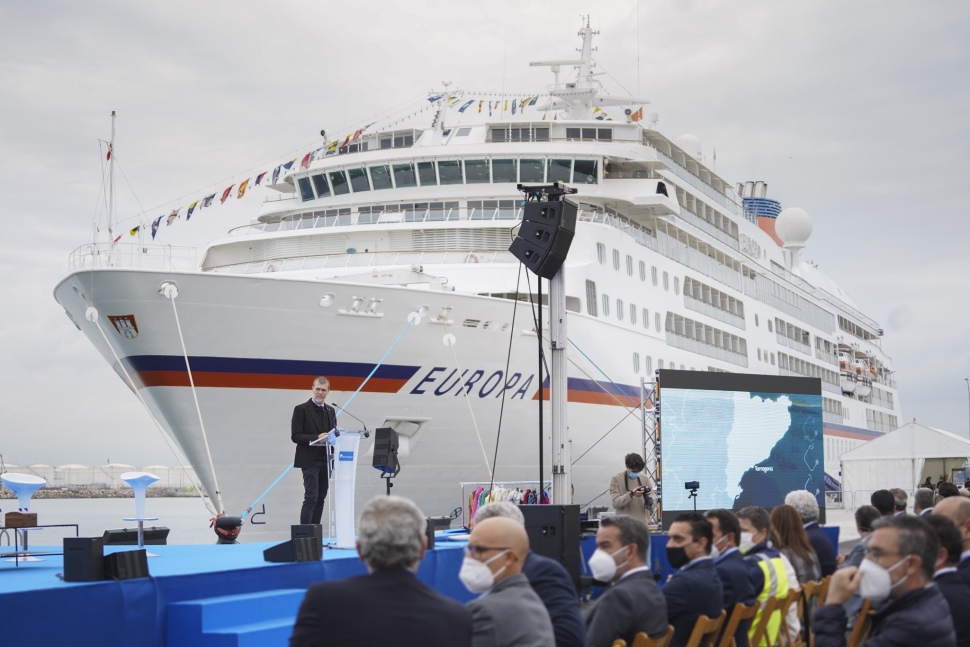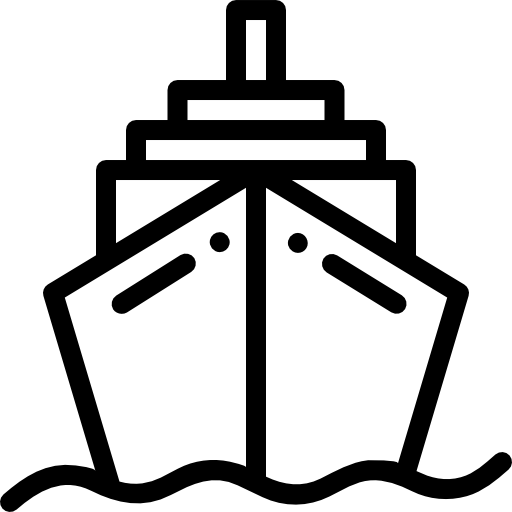Port Tarragona inaugurates the new Balearic Wharf
-
Published in 2021
Josep Maria Cruset announces that the new terminal will surpass the 128,000 passengers of 2019 in two years
More than 30 million euros has been invested in the development of this new infrastructure
Construction of the new wharf was completed in eighteen months
The Port of Tarragona today held the inauguration of the new Balears Wharf, the new multipurpose infrastructure adjoining the Llevant breakwater. The new port facility was presented in a social gathering format attended by Pau Ricomà, Mayor of Tarragona; Josep Maria Cruset, president of the Port of Tarragona; Francisco Toledo, president of the State Ports Authority; Jordi Puigneró, Vice-President of the Regional Government of Catalonia and Minister of Digital Policies and Territory; and Teresa Cunillera, Spanish Government Delegate in Catalonia.
The inauguration of the new Balears Wharf consisted of a welcome speech and a presentation of the Balears Wharf project by the President of the Port of Tarragona, Josep Maria Cruset, who explained the significance of the cruise project for the territory and the work undertaken by the institutional cruise board in its development. To conclude his intervention, Mr Cruset reviewed the construction phases of the Balears Wharf.
The Balears Wharf project presentation was followed by speeches from the institutional representatives in an innovative social gathering format. The questions replied to by the event’s host, Montse Adan, the director of Port-Ciutat, allowed us to learn more about such issues as tourism, infrastructure, sustainability and economic recovery.
After the different interventions of the representatives of the institutions present, the ceremony of twinning with the Balearic Islands was carried out. Josep Maria Cruset, president of the Port of Tarragona, acted as host of this twinning in which Josep Ribas, Minister of Mobility and Housing of the Balearic Islands Government, and Pere Segura, Mayor of Vila-seca, presided over a ceremony that consisted of placing a handful of Mallorcan soil in the bowels of the pier that bears the name of the islands.
The institutional part of the inauguration ended with the unveiling of a commemorative plaque by Dvergastein Dag, captain of the cruise ship Europa, the first liner to dock at the Balears Wharf. The cruise ship captain was accompanied in the ceremony by the main authorities in attendance. The final touch to the event was provided by a cast of some 35 artists, dancers and acrobats as all the attendees were able to enjoy an excerpt from PortAventura World’s, "Around The World" show by Gianfranco Bollini.
Tarragona, on the cruise map
For the president of the Port of Tarragona, Josep M Cruset, "in two years this new wharf will allow us to return to the record figure of 128,000 passengers we reached in 2019". He added that "the construction of the new cruise terminal would mean having a new convenient functional area of more than 5,000 m2 to provide an improved service to cruise ship passengers in the coming seasons”.
In his speech, Mr Cruset highlighted the "step forward" represented by this new infrastructure. The Balears Wharf increases the dockside mooring for cruise liners by 700 metres and offers a much more convenient and agile operation. The infrastructure represents a qualitative improvement for cruise activity, as it opens the door to accommodate larger liners and allows more vessels (up to four) to tie up simultaneously.
The investment of more than 30 million euros has increased by 40 hectares (40,000 m2) the space available for cruise operations. The construction work, carried out by a Temporary Union of Companies (UTE Moll de Balears) formed by FCC and COMSA, began in May 2020, during the first wave of the Covid-19 pandemic. Having overcome all the logistics and sanitary challenges, it was completed a year and a half later.
The new Balears Wharf is prepared to supply electricity to cruise ships while they are berthed. The Port of Tarragona is ready to act with agility when the companies in this sector implement the technology. This service will mean that vessels will not have to burn fossil fuels during their stay in the Port, thus significantly reducing CO2 emissions. In specific terms, the pier has 5 outlet boxes for electricity supply, one of which is already connected to the grid in anticipation of the initial demand from the sector for small and medium-size cruise ships.
Chronology: 10 construction phases in a year and a half
Work on the Balears Wharf began officially in May 2020, with the arrival of the Mar del Aneto, a floating dock, also commonly known as a caisson builder, to construct the concrete foundations of the wharf. In this first phase, part of the breakwater was also removed from the area where the wharf was to be built and dredging began for the uniform preparation of the seabed for the new construction material and caissons to be placed.
In the second phase, the breakwater material was placed with the barges Darss and Zingst, having completed a total of 500 trips between the Vallcarca quarry (El Garraf) and the Port of Tarragona and dumping 645,616 tons of rocks on the seabed.
Caisson placement took centre stage in the third, fourth and fifth phases. This was one of the most complex parts of the project. The 11 caissons were manufactured and placed between August and October 2020 at a rate of one per week. Some 60 people took part in their manufacture, working in shifts twenty-four hours a day, seven days a week. Different port services and personnel, including tugs, boatmen and linesmen, were involved in executing a complex manoeuvre to align and submerge the 11 caissons.
In the sixth phase, in parallel with the placement of the caissons, construction began on the southern and northern breakwaters from sea and the land by bringing in breakwater material and earth. At the same time, the interior cells of the caissons were filled with stone from the Llorito (Tarragona) and Blanco (Reus) quarries.
In January 2021, the dredger Zheng He arrived in the Port of Tarragona to carry out the tasks of the seventh phase. This vessel took one week to fill the new Balears Wharf with more than 600,000 m3 of material dredged from the seabed of the Cantabrian dock in interior waters of the port.
Once the wharf had been completely filled with dredged material, it was the turn of the heavy machinery charged with placing and flattening all the sand and earth dumped by the dredger, with the aim of creating and levelling the 40,000 m2 esplanade.
During the month of March, work on the Balears Wharf entered its eighth phase: the installation of the edge beam. This is a reinforced concrete beam 5.40 m wide and 1.70 m thick that runs along the entire length of the outer and inner dock as an enclosure for the esplanades, achieving the correct alignment of the wharf and allowing the anchoring of 33 fenders and 33 bollards.
In the ninth phase, which began during the summer of 2021, work was carried out simultaneously on the completion of the edge beam, the placement of the defences and bollards, and the start of the esplanade paving. A total of 33 bollards with a holding capacity of 200 tons each has been installed. They will be able to provide a mooring service to the largest cruise ships in the world.
The tenth and final phase consisted of installing lighting, horizontal signage and other services to allow the Balears Wharf to receive vessels and attend to embarking and disembarking passengers.
The first cruise ship on the Balears Wharf
The first liner to dock on the new Balears Wharf is the Europa belonging to Hapag Lloyd Cruise Lines, which arrived from Palma de Mallorca and is bound for Málaga. The 400-passenger-capacity vessel arrived in Tarragona this morning at 07:00 with 240 cruise passengers on board, mostly German citizens. They will enjoy a 12-hour stopover to visit the city.
The Port of Tarragona’s cruise season began in September with the arrival of the vessel Bolette, which brought to an end an 18-month hiatus in cruises in Tarragona due to the Covid-19 pandemic, a state of alarm that forced the cessation of cruise activity worldwide.
Throughout 2020 and 2021, the Port of Tarragona has been in a constant state of preparedness to resume its cruise vessel activity, both in operational and logistics terms as well as in the application of health measures arising from the Covid-19 pandemic. Thanks to all this work, in 2021 it expects to receive up to six cruises, a figure that will increase progressively during 2022. At present, bookings for 2022 put the expected number of passengers at around 60,000 with some 30 stopovers.
The evolution of the cruise project in Tarragona
The Balears Wharf will strengthen and improve the Costa Daurada’s tourism diversification and deseasonalisation strategy. It is an activity with the opportunity to grow in the coming years and generates business in the months before and after the summer high season.
The Tarragona cruise project is a task undertaken with the consensus of the territory’s main institutions, which are represented on the Institutional Cruise Board. The main administrations, entities and companies in the tourism sector of the Costa Daurada are present: Turisme de Catalunya, URV (Eurecat Department of Tourism Innovation - Technological Centre of Catalonia), Tarragona Provincial Government, Tarragona Chamber of Commerce, the town councils of Tarragona, Reus and Vila-seca, PortAventura, Reus Airport and the Province of Tarragona Federation of Hospitality and Tourism Entrepreneurs.
Between 2013 and 2019, the cruise project has accounted for almost 200 stopovers (196 to be exact) and more than 300,000 cruise passengers (305,888). The efforts of all the institutions involved have succeeded in multiplying the number of stopovers by 20 between 2013 and 2019, going from three in 2013 to 63 in 2019 and the number of passengers by one hundred in just 7 years, from 1,394 in 2013 to 128,000 in 2019.
The cruise activity in the Port of Tarragona attracts a wide diversity of tourists from Europe and America. The most numerous are Italians (90,661); the second largest group is British tourists (51,793); and the third, fourth and fifth respectively are 36,927 from France, 14,900 from North America and 14,000 from Germany. The historical, cultural and gastronomic heritage has persuaded 94% of cruise passengers who stop over in Tarragona to visit destinations on the Costa Daurada: Tarragona (Tarraco Romana, Altafulla, Salou and Port Aventura), Baix Camp (Reus and Cambrils), Alt Camp (Monastery of Santes Creus and Nulles cooperative winery), Conca de Barberà (Poblet Monastery and Montblanc), Priorat and the Ebro Delta. Excursions, activities and consumer services generate a positive economic impact of some 10 million euros each year (9.7 million euros in exact terms).
The tourist attractions receive very high ratings each year according to the URV's satisfaction monitoring. The cruise passengers rate our destination as excellent (overall rating 9 out of 10) and 94.2% of visitors say they will recommend Tarragona/Costa Daurada to their friends and family.
The Balears Wharf in figures
• Built in 17 months, overcoming the obstacles arising from the Covid-19 pandemic between May 2020 to September 2021
• Cost: 30 million euros
• The barges Darss and Zingst* made out a total de 500 voyages between the Vallcarca quarry (El Garraf) and the Port of Tarragona, a total of 27,000 km to transport 645,616 tons of ballast material.
• The floating dock Mar del Aneto** manufactured the 11 caissons for the new wharf at a rate of one per week.
• 60 people working in shifts twenty-four hours a day, seven days a week built 11 caissons at a rate of one per week.
• Each caisson is 41.05 m long, 16.75 m wide and 21.30 m high.
• An empty caisson weighs 7,288.80 tons, while a full one weighs 33,440.65 tons.
• The dredger Zheng He*** dredged material from the seabed on the Cantabrian Wharf to fill the Balears Wharf. In one week it was able to contribute 600,000 m3 of fill to the wharf.
• The construction of the edge beam required 6,400 m3 of concrete.
Final characteristics
• New wharf with 4 hectares of surface area (40,000 m2)(40.000 m2)
• 700 metres of cruise liner mooring: 460 m exterior and 240 m interior
• 33 fenders and 33 bollards with 200-ton load capacity
• Pre-installation for electricity supply to small and medium-sized cruise ships
Cruise activity expansion and improvement
• Ability to receive 4 cruise liners simultaneously
• Ability to accommodate the largest cruise ships in the world
• New terminal and improvement of passenger operating services
• Communications and mobility improvements
*This type of barge that unloads stone by opening the bottom of the boat. Darss and Zingst are the names of the vessels. **A vessel that can manufacture "huge cement caissons" to make the exterior of the dock where the vessels tie up. ***Vessel name.
Balears Wharf Construction Phases
Also available at: https://www.porttarragona.cat/ca/autoritat-portuaria-tarragona/comunicacio-premsa/notes-premsa/item/2425-les-obres-del-nou-moll-de-balears-transformaran-la-fesomia-del-port-de-tarragona
Link to the videos shown during the inauguration ceremony:
Vídeo 1. Costa Daurada. https://www.youtube.com/watch?v=qLo58wUFZV4
Vídeo 2. Cruise liners. https://www.youtube.com/watch?v=qB5XEdIpICo
Vídeo 3. Moll de Balears. https://www.youtube.com/watch?v=L9n3PDRBxA8






















